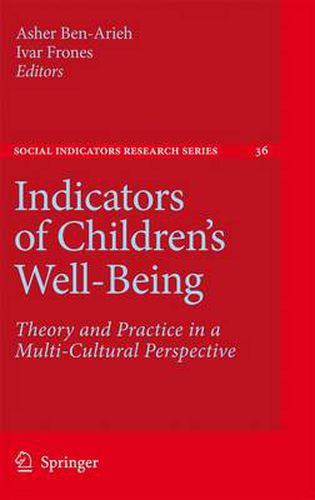Readings Newsletter
Become a Readings Member to make your shopping experience even easier.
Sign in or sign up for free!
You’re not far away from qualifying for FREE standard shipping within Australia
You’ve qualified for FREE standard shipping within Australia
The cart is loading…






This title is printed to order. This book may have been self-published. If so, we cannot guarantee the quality of the content. In the main most books will have gone through the editing process however some may not. We therefore suggest that you be aware of this before ordering this book. If in doubt check either the author or publisher’s details as we are unable to accept any returns unless they are faulty. Please contact us if you have any questions.
The measuring and monitoring children’s well-being is of growing importance to policymakers and those who strive to improve the lives of children everywhere. In the last decade, public attention has centered on children, a development driven by decreasing fertility in the most developed countries of the world and the postindustrial emphasis on human capital development. These developments position children at the center of the future capacity of a nation or region. Children have increasingly been identified as subjects with rights and entitlements of their own, as illustrated by the U. N. Convention on the Rights of the Child (CRC), which emphasizes a child’s right to develop his or her capacities. The CRC represents a milestone both in the understanding of children and in offering principles and guidelines for policies. The rights underscored by the convention require evidence on children’s well-being and theories or models for understanding their evolving capacities and development. The right to develop one’s capacities illustrates a complexity of analyzing children’s well-being: the analysis must encapsulate both the current standard of living and the potential for growth and future fulfillment arising from present conditions. Of course, systematic statistics on children have existed for a long time. However, new development in data and analytic resources and growing interest in childhood among social scientists have combined to advance child well-being to the forefront of research.
$9.00 standard shipping within Australia
FREE standard shipping within Australia for orders over $100.00
Express & International shipping calculated at checkout
This title is printed to order. This book may have been self-published. If so, we cannot guarantee the quality of the content. In the main most books will have gone through the editing process however some may not. We therefore suggest that you be aware of this before ordering this book. If in doubt check either the author or publisher’s details as we are unable to accept any returns unless they are faulty. Please contact us if you have any questions.
The measuring and monitoring children’s well-being is of growing importance to policymakers and those who strive to improve the lives of children everywhere. In the last decade, public attention has centered on children, a development driven by decreasing fertility in the most developed countries of the world and the postindustrial emphasis on human capital development. These developments position children at the center of the future capacity of a nation or region. Children have increasingly been identified as subjects with rights and entitlements of their own, as illustrated by the U. N. Convention on the Rights of the Child (CRC), which emphasizes a child’s right to develop his or her capacities. The CRC represents a milestone both in the understanding of children and in offering principles and guidelines for policies. The rights underscored by the convention require evidence on children’s well-being and theories or models for understanding their evolving capacities and development. The right to develop one’s capacities illustrates a complexity of analyzing children’s well-being: the analysis must encapsulate both the current standard of living and the potential for growth and future fulfillment arising from present conditions. Of course, systematic statistics on children have existed for a long time. However, new development in data and analytic resources and growing interest in childhood among social scientists have combined to advance child well-being to the forefront of research.